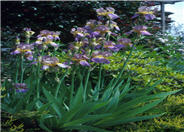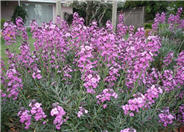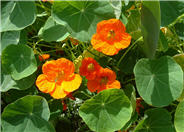
Common name:Bearded Iris
Botanical name:Iris Bearded Hybrids
This perennial will grow 1'-3' tall and has medium sized, blue green leaves with flowers of different colors that bloom in spring. It needs well draining soil and full sun. Many are fragrant and rebloom in the fall. Plant rhizomes in Sept or Oct. They need water once a week during the hot spells. Top dress with compost and gypsum in January and August.

Common name:Bowles Mauve Wallflower
Botanical name:Erysimum 'Bowles Mauve'
This shrubby evergreen perennial reaches a size of 3' tall and 6' wide with narrow, dark foliage and a dense habit. Its flowers always emerge as mauve purple, and are produced on 4' tall stalks. Blooms throughout warm months. It can bloom continuously in mild climates. It should receive sun to part shade, with little or no summer watering. It is hardy to frost.

Common name:Garden Nasturtium
Botanical name:Tropaeolum majus
This garden annual/groundcover will grow less than 1' tall, but will spread and climb up to 6'. Nasturtium has 2" light green leaves with red, orange, yellow, or white flowers that are in constant bloom throughout the warm season. This plant usually reseeds, with new plants emerging in early spring. This plant does better with regular watering. Some folks put the leaves and flowers in salads!

Common name:Snow-In-Summer
Botanical name:Cerastium tomentosum
Masses of snow white flowers highlight this plant during the early summer season. This attractive ground cover is a great filler among other plants and rocks. Foliage is silver gray or gray/green and is woolly. This plant tolerates coastal conditions and desert areas. Use in rock settings, in hanging baskets, containers, or as a lawn substitute. Cut back in fall to refresh plant.
| Designer: | Flower Garden View throught the Irises |
Photographer: GardenSoft |
Soils and Compost:
Practice grass-cycling by leaving short grass clippings on lawns after mowing, so that nutrients and organic matter are returned to the soil.
Water Saving Tip:
Replace turf with groundcovers, trees, and shrubs. If you have areas where no one uses the grass, patches that do not grow well, or a turf area too small to water without runoff, consider replacing the turf with water-efficient landscaping.
Integrated Pest Management:
Remove irrigation water and fertilizer from areas where you don't want weeds to grow.

